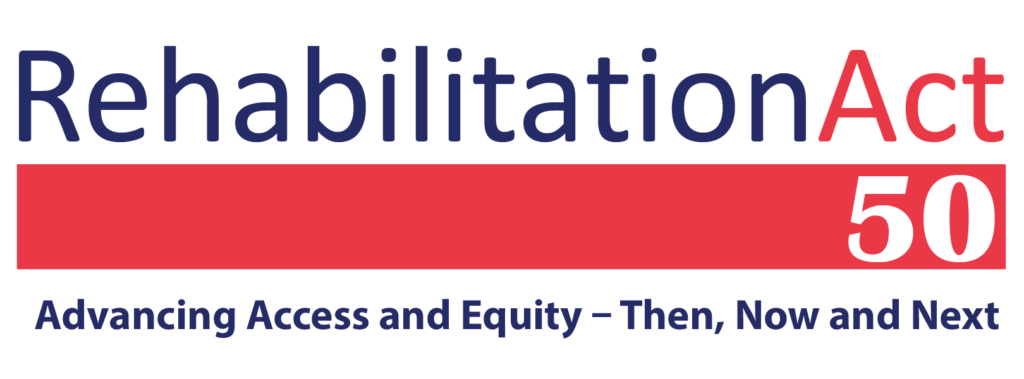
Turning 50 is a time to look back with pride and look forward with hope.
The 50th anniversary of the Rehabilitation Act of 1973 stands strong as the first civil rights legislation protecting people with disabilities from discrimination by federal agencies, federal contractors, or programs receiving federal funds.
Passage of the Rehab Act and promulgation of implementing regulations even engenders pride. The legislation survived two vetoes before it was signed by President Richard M. Nixon on September 26, 1973. And signing of section 504 regulations in 1977 during the Carter Administration took government building sit-ins of 150 disabled activists and allies. A national disability movement was launched culminating in passage of the Americans with Disabilities Act of 1990 broadening civil rights protections to the private sector.
Want to subscribe to receive blog updates sign up today!
The scope and influence of the Rehab Act then and now is huge:
- Section 501 established a federal government interagency committee on handicapped employees (now known as the President’s Committee on Employment of People with Disabilities).
- Section 502 established the Architectural and Transportation Barriers Compliance Board (Access Board) tasked with ensuring access to federal buildings and facilities. Later amendments strengthened requirements for access to (1) electronic and information technology in the Federal sector (Section 508) and (2) medical diagnostic equipment (section 510).
- Section 503 prohibits federal contractors and subcontractors from discriminating in employment against individuals with disabilities and requires employers to take affirmative action to recruit, hire, promote, provide benefits, train, and any other term, condition, or privilege of employment. The Office of Federal Contract Compliance at the U.S. Department of Labor is responsible for enforcing section 503.
- Section 504 prohibits discrimination based on disability in any program or activity operated by recipients of federal funds. The U.S. Justice Department coordinates section 504’s consistent and effective implementation with over 35 federal agencies.
And as for looking forward with hope, consider commenting—on or before November 13, 2023—on the proposed rule by the Office for Civil Rights, Department of Health and Human Service. Among other things, the rule covers accessible medical equipment, such as exam tables and scales; medical treatment decisions; value assessment, web and mobile accessibility; and community integration.
“These new regulations could provide a critical framework for forcing medical providers to provide more accessible, equitable healthcare. That’s why it’s so important that you take the time to comment. Share your personal experiences as a wheelchair user and how lack of accessibility affects your medical care. It is critically important to support eliminating medical disparities that have complicated and shortened our lives and blocked us from having equal health care for the past 50 years … and into the future.”
Tim Gilmer, editor of New Mobility magazine.
To dig deeper go to:
- Rehabilitation Act of 1973 (Original Text). September 26, 1973. https://www.eeoc.gov/rehabilitation-act-1973-original-text
- “Employment Protections Under the Rehabilitation Act of 1973: 50 Years of Protecting Americans with Disabilities in the Workplace.” Equal Employment Opportunity Commission. https://www.eeoc.gov/employment-protections-under-rehabilitation-act-1973-50-years-protecting-americans-disabilities
- Rehabilitation Act 50. “Advancing Access and Equity: Then, Now and Next.” https://www.dol.gov/agencies/odep/initiatives/rehabilitation_act_50
- “Justice Department Celebrates 50th Anniversary of the Rehabilitation Act.” Tuesday, September 26, 2023. https://www.justice.gov/opa/blog/justice-department-celebrates-50th-anniversary-rehabilitation-act
- Tim Gilmer. “Comment Now to Support Critical Regulations to Make Medical Care More Accessible.” New Mobility. October 4, 2023. https://newmobility.com/comment-now-to-support-critical-regulations-to-make-medical-care-more-accessible/?mc_cid=5eaf3ea856&mc_eid=7d6d6ed7fb
- Discrimination on the Basis of Disability in Health and Human Service Programs or Activities. A Proposed Rule by the Health and Human Service Department on 09/14/2023. Federal Register. https://www.federalregister.gov/documents/2023/09/14/2023-19149/discrimination-on-the-basis-of-disability-in-health-and-human-service-programs-or-activities
- Angela Muir Van Etten. “Tackling Inaccessible Medical Equipment, Part II.” Blog post, March 28, 2022. https://angelamuirvanetten.com/tackling-inaccessible-medical-equipment-part-ii/
- Angela Muir Van Etten. “Tackling Inaccessible Medical Equipment.” Blog post, April 19, 2021. https://angelamuirvanetten.com/tackling-inaccessible-medical-equipment/
